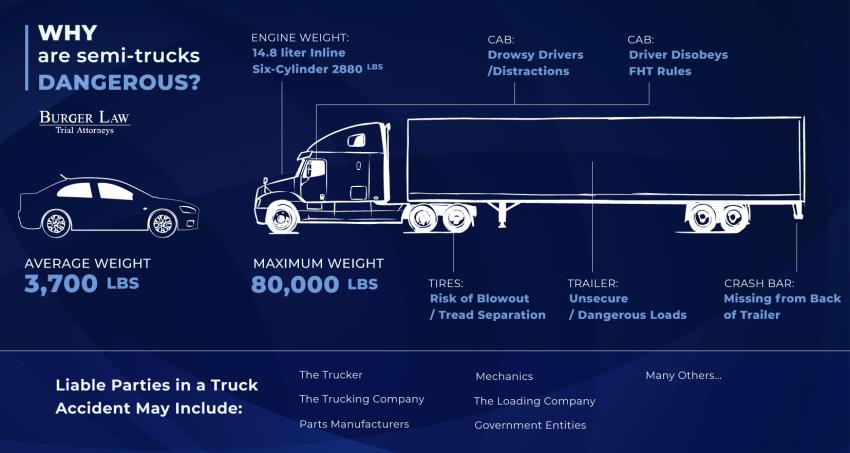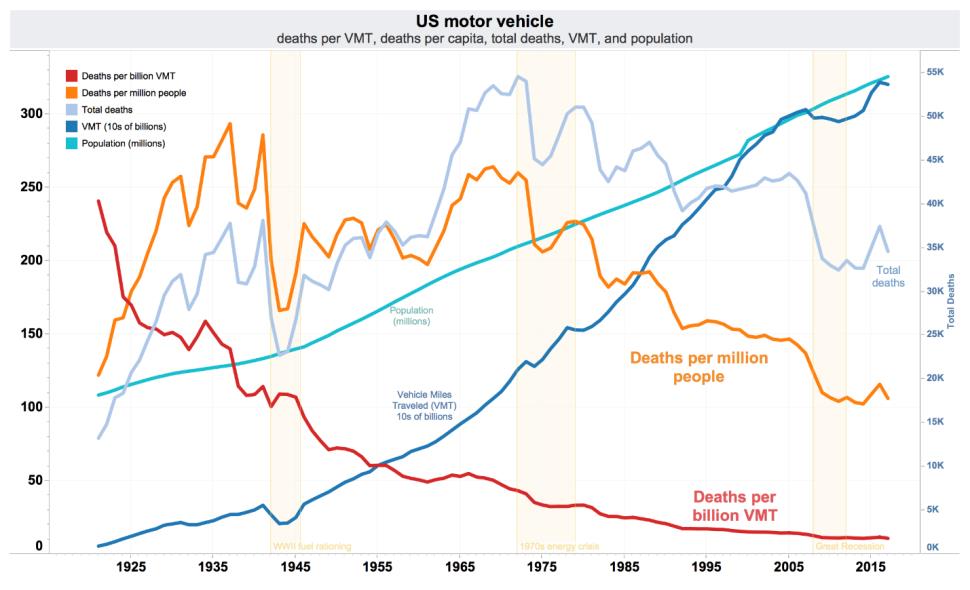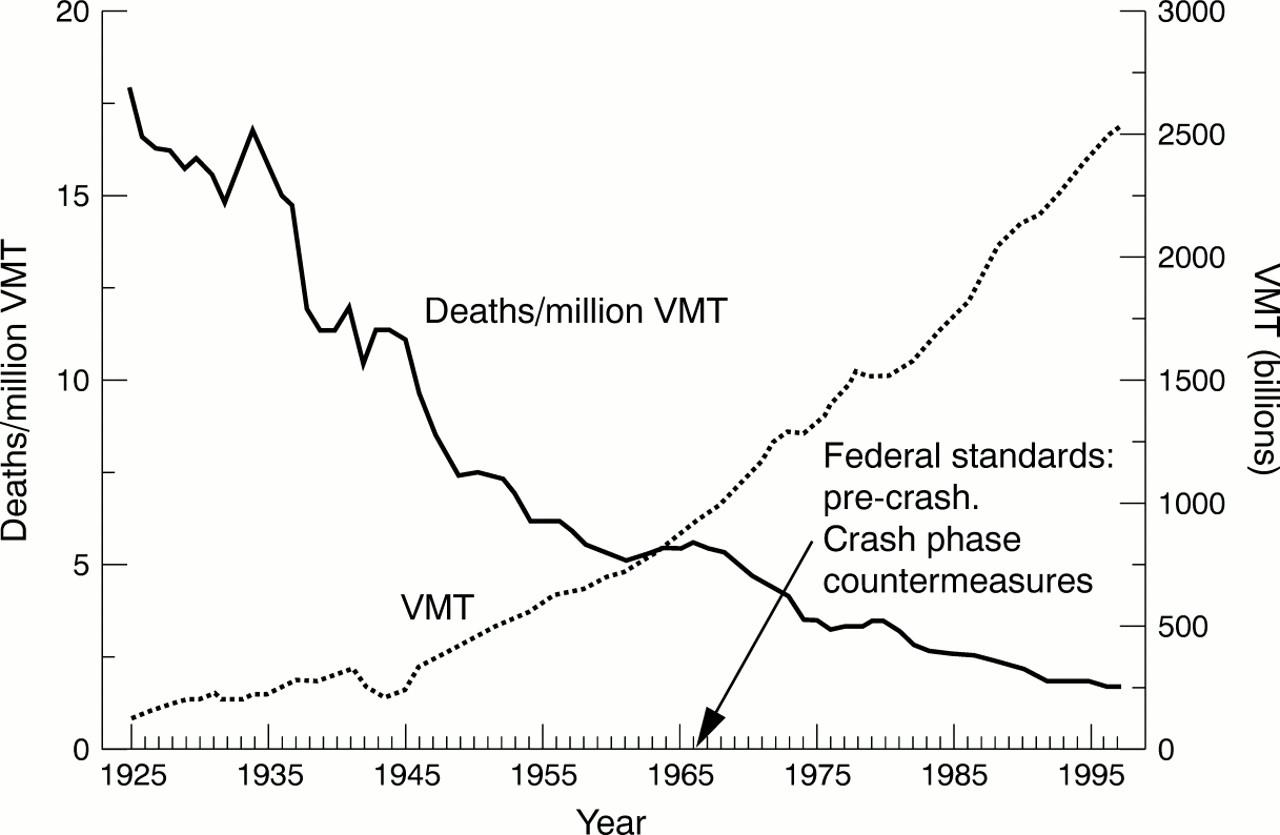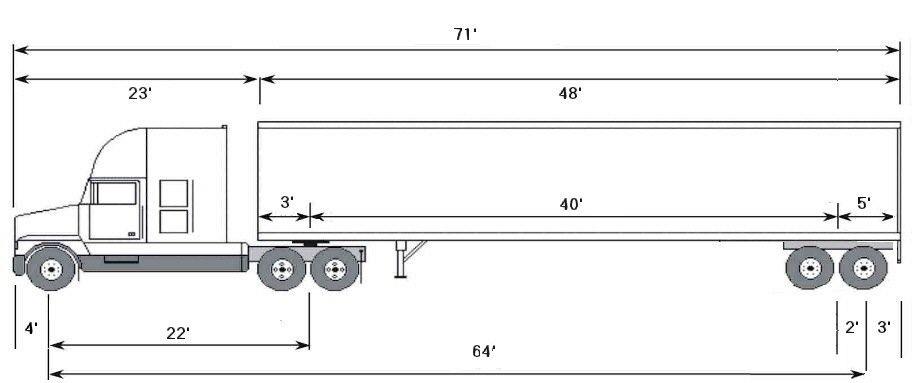Introduction and the Basics
Truck crashes happen frequently and can cause devastating personal injuries and significant property damage. A quick overview of the statistics will illustrate just how serious truck crashes are. According to the National Highway Traffic Safety Administration (NHTSA), in 2018 there were 151,000 people injured in crashes involving large trucks and an estimated 531,000 large trucks were involved in police-reported traffic crashes. In 2018, truck crashes killed 4,591 people in the United States--almost a one-percent increase from 2017. That figure includes 129 people killed in Missouri and 166 people in Illinois. Of the people killed in large truck crashes in the US in 2018, seventy-one percent were occupants of the other vehicle, not the large truck. Large-truck drivers involved in fatal crashes had a higher percentage of previous crashes compared to drivers of other vehicle types, namely motorcycles, passenger cars, and light trucks. Moreover, large trucks made up 9.4 percent of all vehicles involved in fatal crashes, while only accounting for 4 percent of all registered vehicles. That's twice as many deaths as cars, due to the size and force of over-the-road tractor trailers.
Drivers who violate safety rules which cause traffic crashes needlessly injure and kill people. There are many good truck drivers and trucking companies in America. Those professionals often are even more critical of bad drivers than us lawyers. Good drivers and their companies focus on safety, defensive driving, adherence to federal and state rules and regulations, and have robust training and programs to make sure they drive safely.

But those drivers who take shortcuts, value texting and social media while driving, drive too long and when tired, drive under the influence, try to rush to make a delivery, engage in road rage and who otherwise break the Rules of the Road, should be held responsible for the harm they cause. Even some experienced drivers, who have driven for years or decades sometimes forget about the importance of safety rules while driving or get complacent. We are all trained to follow the Rules of the Road and to operate motor vehicles safely – that’s the agreement we make to drive and the social contract we execute. The Rules of the Road are also the law. Rule violations that typically result in injury or death are excessive speed, failure to keep a careful lookout, failure to yield the right of way and violations of traffic signals (set out in Missouri Approved Instructions 17.01 et seq.). Under Missouri law, drivers must use the “highest degree of care” or what “a very careful person” would do under the same circumstances (MAI 11.01). Other states have similar laws. In Illinois, lawyers, judges and juries use section 72 of the Illinois Pattern Instructions. Visit this link for a full overview of traffic law in the United States.
Truck crash statistics in the United States are sobering – and the states with the largest percentages of truck crashes are in the middle of the country, including Missouri and Illinois. And compared to crashes involving other types of vehicles, truck crashes result in far greater injuries to people and property. This is why you need a good lawyer when you are seriously injured or have a family member killed in a truck crash. Truck crashes cause serious and permanent injuries, pain and suffering, and leave victims with mountains of medical bills. Oftentimes insurance companies act like bullies and try to settle your claim for as little as they can get away with paying. One of the main reasons I became a personal injury attorney is because I don’t like bullies and I like to stand up for those who are bullied. This includes standing up for truck crash victims when they have to deal with trucking insurance companies.
In my book “Ten Mistakes That Wreck Your Car Crash Case,” one of the chapters discusses how people can handle their car accident claims without hiring a lawyer. I suggested that in a car crash where an individual only has minor injuries and low medical bills, a lawyer cannot add much value. However, for the people seriously injured in a wreck, it is imperative to hire a skilled, competent lawyer who will fight to see you fully compensated for your medical costs and for your pain and suffering. For this reason, I wanted to write a book solely dedicated to providing information to individuals involved in serious truck crashes.
When you are in a trucking accident, you only have a claim for personal injuries if the truck driver was negligent, or caused injury to you. If the accident was your fault, no one else should pay you for your injuries, unless you had medical payment benefits or some other benefits through your insurance. If the truck driver broke the rules of the road, drove unsafely and carelessly and injured you or a passenger, you do have a claim. Those claims usually divide into property damage and personal injury claims. Usually, you should handle your property damage claim yourself as you never want a lawyer to take a fee out of the money recovered for your vehicle - you are already not going to get full value for your vehicle damage. Insurance companies pay wholesale or other reduced value to pay for property damage – but you can argue for a higher value.
Make sure you get all your medical care quickly and thoroughly after the truck crash. You will want to undergo treatment until you are at your maximum medical improvement. For a medical or personal injury claim, hire a lawyer for moderate and severe injuries and consider resolving small claims yourself. Be careful in dealing with insurance companies – some are fair but many cannot be trusted. They are incentivized to treat you unfairly – caveat vendor or seller beware – and you are selling your claim.
Review of this book will provide you with an overview of what to know about your truck crash case. Below I discuss why truck crashes are so dangerous, damages you can recover, legal claims you should bring, and laws and regulations truck drivers are required to follow, among other things. My goal is to give you a comprehensive understanding of what to expect in your truck crash case and why it is important to have a good truck crash lawyer
Special thanks to Michael Sheldon and Nishant Patel – two graduating third year law students who will be great lawyers - for their great help in writing this book.

[caption id="attachment_25088" align="aligncenter"]
 Vehicle deaths per million miles traveled since 1925. While as you can see more cars are on the road and fewer fatalities are occurring, danger still remains on American roads. Attorney Gary Burger is ready to help if you ever are in a car or truck accident.[/caption]
Vehicle deaths per million miles traveled since 1925. While as you can see more cars are on the road and fewer fatalities are occurring, danger still remains on American roads. Attorney Gary Burger is ready to help if you ever are in a car or truck accident.[/caption]
Common Causes of Truck Crashes
Truck crashes are extremely dangerous and cause tremendous damage, as can be seen in this photo from one of my cases. It’s unfortunate that most truck crashes are due to driver error and are preventable. In this chapter I will discuss some of the common causes of truck accidents and the reasons why they are so dangerous.

Driver fatigue is one of the leading causes of truck crashes. Truck drivers have high-stress jobs that involve high pressure. Trucking companies typically require drivers to deliver freight to far-away destinations within short periods of time. Consequently, truckers drive long distances with short breaks and little sleep. Long-distance routes keep truck drivers behind the wheel for several days at a time and small sleeper cabs result in low-quality sleep. Drivers are therefore slower to react and have diminished concentration. Some truck crashes even result from drivers falling asleep behind the wheel. While laws regulate the number of hours drivers can work per shift, some trucking companies do not comply and encourage their drivers to exceed the permitted hours.
Another major cause of truck wrecks is improper training. Too many truck companies fail to provide adequate behind-the-wheel, supervised training. We have handled many cases involving little or no training following a driver getting their Commercial Driver’s License (CDL). I have had drivers testify to no training, too little training, or one driver saying the majority of his training revolved around product handling, and he only received about a week of supervised behind-the-wheel time. Sometimes drivers fail training tests and are not re-educated on the driving problem they have, or drivers fail a portion of their CDL test. Unfortunately, some trucking companies rush through the training process so that they can get their drivers on the road quicker. They look to hire young and inexperienced drivers who they can pay less, and then send them out on the road without proper training. Other companies fail to properly investigate their employees’ driving records and hire unqualified drivers. Shortcuts to save money usually cost more in the long run.
Speeding, distracted driving, and substance abuse are also among the lead causes of truck crashes. In an effort to meet tight deadlines, truck drivers often speed or drive too fast for weather conditions. They bear down on smaller vehicles from behind and cause them to swerve into other lanes. Truckers often become bored on long routes and are tempted to look at their phones. Moreover, a recent study shows that approximately thirty percent of truck drivers admitted to taking illegal substances on the job. It is not uncommon for drivers to take amphetamines and stimulants to stay awake while driving. We know all of these rule violations because we see them on the road. How many close calls or bad wrecks have you personally seen?
The other leading cause has to do with the mass of trucks. Over the road and even local delivery trucks usually weigh between 60 and 80,000 pounds. Compare this to your 3,350-pound sedan. So, trucks take longer to stop, decelerate slower, and have more inertia and force (Force = mass times acceleration). Many Rules of the Road and good training instructions require truck drivers to be watching 15 seconds ahead of themselves, to keep an extra distance from the vehicle in front of them, stop sooner, go slower in inclement weather, use both their braking systems, drive defensively and be prepared to stop at turning traffic lights and thick traffic.
So why are truck crashes so dangerous? Well, again because of the sheer size and weight of tractor-trailers. Trucks are substantially heavier than other vehicles. The NHTSA defines a large truck as any truck with a gross vehicle weight rating greater than 10,000 pounds. However, large tractor-trailer trucks can weigh up to 80,000 pounds. On the other hand, the U.S. Environmental Protection Agency estimated that the average weight of a car in 2018 was 4,094 pounds, with compact cars weighing on average 2,919 pounds. This means that large tractor-trailers can weigh about 20 times more than cars.
With such a great weight disparity between large trucks and cars, it should come as no surprise that smaller cars are at a serious disadvantage in collisions. In fact, according to the EPA, every 1,000-pound disadvantage increases the risk of fatality by forty-seven percent. When a large truck and car collide, the car sustains significantly more damage and its occupants are more likely to be injured or killed than the truck driver. As mentioned in the Introduction, data published by NHTSA shows that seventy-one percent of people killed in truck crashes in 2018 were occupants of other vehicles, not the truck.
Another factor that makes truck crashes so dangerous is that the enormous weight of large trucks requires greater braking distances to come to a complete stop. So reacting sooner to stopped cars and red lights, giving more space to the vehicle in front of them, and watching the road 10 to 15 seconds in front of them, are requirements for safe drivers. These are not an option. A tractor trailer’s enormous weight also causes them to accelerate slowly, and truckers often misjudge the amount of time it takes to make turns or merge with traffic.
Trucks are also tall, making them unstable compared to cars, especially when their trailers are loaded improperly. Improper loading can cause top-heavy cargo to shift in transit, which can lead to the truck overturning or losing control. Additionally, the height of trucks makes them more vulnerable to rollovers from swerving, hard cornering, and strong gusts of wind. When trucks take evasive maneuvers, they can yaw and slide sideways, causing reduced traction.
Finally, the last physical aspect of trucks that makes them different is their length. Their substantial length creates large blind-spots for the truck driver on all sides of the vehicle. These large blind-spots are often referred to as “no-zones.” While truck drivers are trained to pay close attention to traffic entering and leaving the “no-zones,” this often does not happen. Additionally, the length of trucks requires truck drivers to make wide swing turns which can catch other motorists off guard. Cars caught in these blind spots get hit – whether from a truck changing lanes, taking a turn, or backing up. Smart drivers pass trucks quickly and do not linger in their blind spots. It is kind of sad that car and motorcycle drivers have to always be vigilant for dangerous truck drivers not minding their blind spots.

